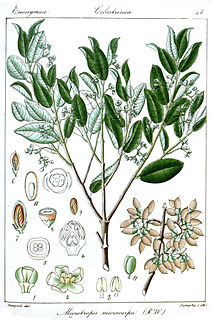A green spotted puffer may be one of several different species of Asian fresh or brackish water pufferfish in the genus Dichotomyctere, including:
Beauprea congesta is a species of plant in the family Proteaceae. It is endemic to New Caledonia.
Beauprea crassifolia is a species of plant in the family Proteaceae. It is endemic to New Caledonia.

Helicia is a genus of 110 species of trees and shrubs, constituting part of the plant family Proteaceae. They grow naturally in rainforests throughout tropical South and Southeast Asia, including India, Sri Lanka, Indochina, Peninsular Malaysia to New Guinea and as far south as New South Wales.
Helicia albiflora is a species of plant in the family Proteaceae. It is endemic to Papua New Guinea. It is threatened by habitat loss.
Helicia amplifolia is a species of plant in the family Proteaceae. It is endemic to Papua New Guinea. It is threatened by habitat loss.
Helicia insularis is a species of plant in the family Proteaceae. It is endemic to Papua New Guinea. It is threatened by habitat loss.
Helicia neglecta is a species of plant in the family Proteaceae. It is endemic to Papua New Guinea. It is threatened by habitat loss.
Microtropis argentea is a species of tree in the family Celastraceae. It is endemic to Borneo, where it is confined to Sarawak.

Microtropis is a genus of plant in family Celastraceae. There are about 70 species. They are trees and shrubs, evergreen or deciduous, with oppositely arranged leaves and white or yellowish flowers. Microtropis are distributed in Asia, Africa, and Central America.
Microtropis borneensis is a species of plant in the family Celastraceae. It is endemic to Borneo.
Microtropis densiflora is a species of plant in the family Celastraceae. It is endemic to Tamil Nadu in India.
Microtropis fascicularis is a species of plant in the family Celastraceae. It is endemic to Borneo where it is confined to Sarawak. It is a deciduous shrub normally ranging in height from 1–5 m, though sometimes it can scramble higher into the crowns of taller trees. Its stems are covered with small, sharp, hooked spines, which aid it in climbing. The leaves are pinnate, with 5-7 leaflets. The flowers are usually pale pink, but can vary between a deep pink and white. They are 4–6 cm diameter with five petals, and mature into an oval 1.5–2 cm red-orange fruit.
Microtropis keningauensis is a species of plant in the family Celastraceae. It is endemic to Borneo where it is confined to Sabah.
Microtropis rigida is a species of plant in the family Celastraceae. It is a tree endemic to Borneo where it is confined to Sarawak.
Microtropis sarawakensis is a species of plant in the family Celastraceae. It is a tree endemic to Borneo where it is confined to Sarawak.
Microtropis tenuis is a species of plant in the family Celastraceae. It is a tree endemic to Peninsular Malaysia. It is threatened by habitat loss.
Roupala pinnata is a species of plant in the family Proteaceae. It is endemic to Peru.
Zinowiewia costaricensis is a species of tree in the family Celastraceae. It is found in Belize, Costa Rica, Nicaragua, and Panama. It is threatened by habitat loss. The plant is used medicinally.

Tisis is a genus of small moths in the family Lecithoceridae. The genus was erected by Francis Walker in 1864.



